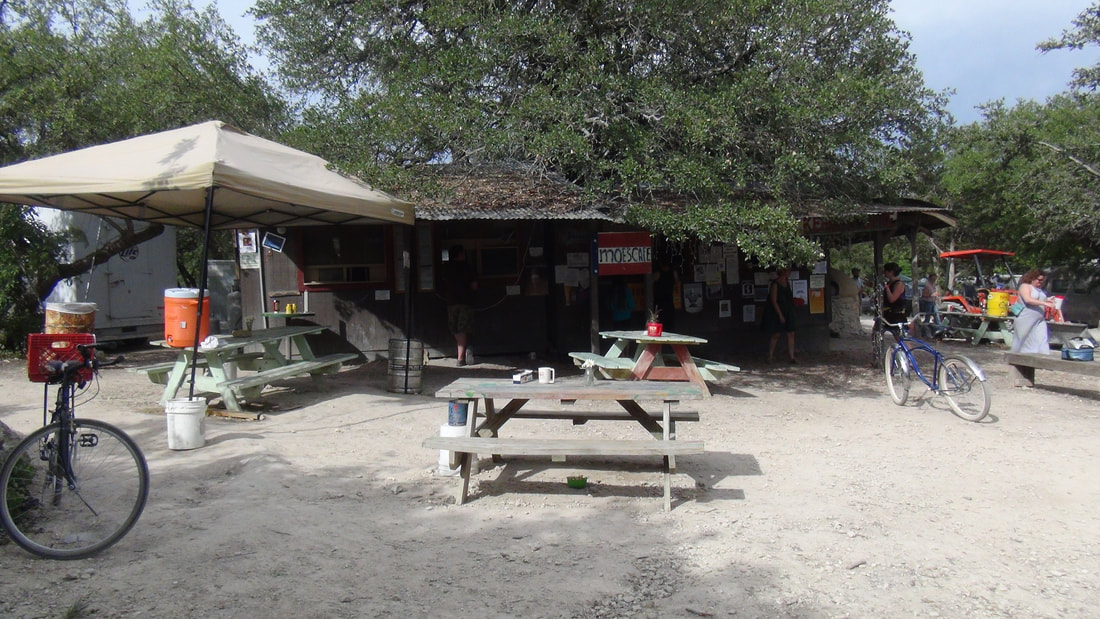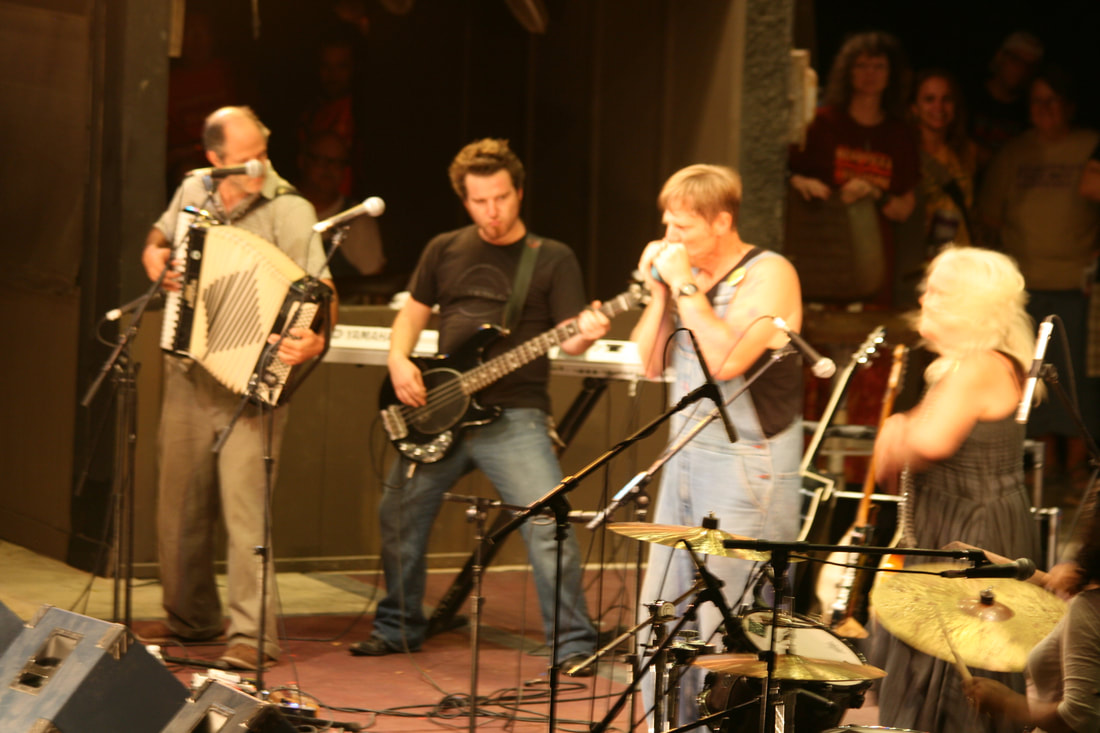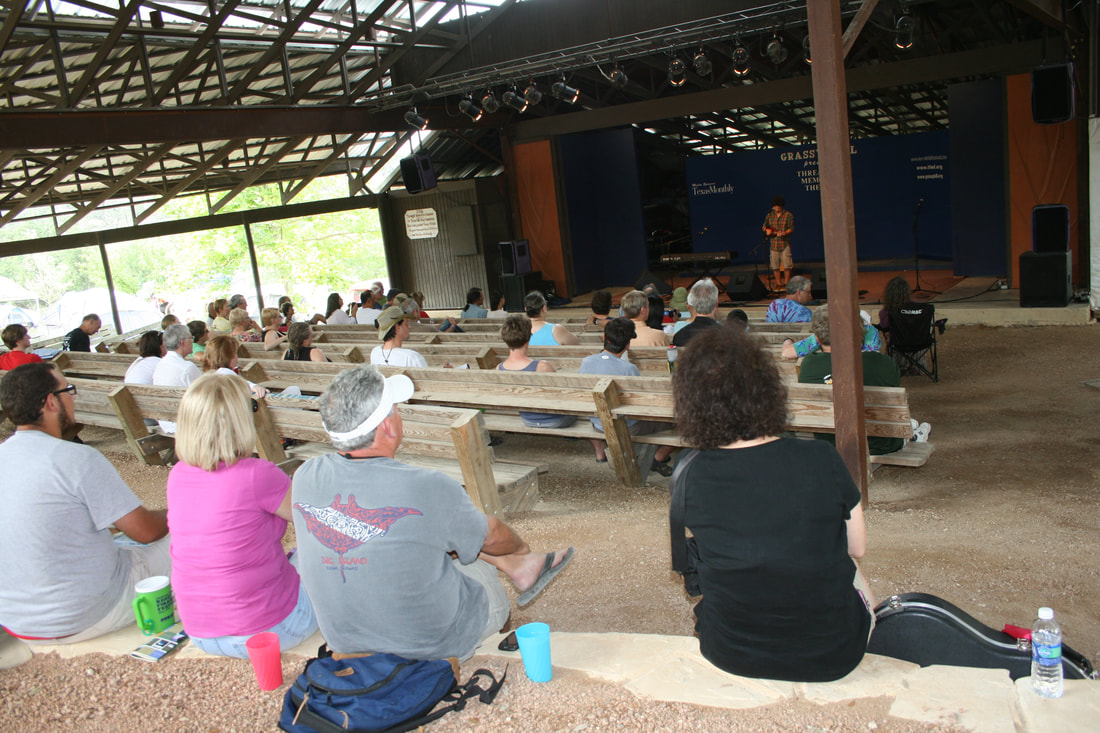For Aspiring Singers and Songwriters, a 45-Year Tradition
|
By JOE CARTWRIGHT
Special to North Palm Beach Life Every year, for the last 45 years, an area south of Kerrville, Texas becomes a gathering site for aspiring songwriters from all over the nation, and a few foreign countries. For 18 days, singers and songwriters gather at the Quiet Valley Ranch to share songs, perform around campfires, and listen to singers not many people have heard of – yet. The Kerrville Folk Festival applies a very wide definition to “Folk” music, including blues, bluegrass, country, rock, and other acts that often defy categories. In 1972 Rod Kennedy, a music promoter and club owner from Austin, set up a series of concerts over three days in June, at the Kerrville Municipal Auditorium. Prominently seated near the front in those first concerts were some local celebrities: Darrell Royal (then head football coach at The University of Texas) and Lyndon and Lady Bird Johnson. The concerts were very successful – about 2800 people attended – and were repeated in 1973. The second Festival featured Willie Nelson and B. W. Stevenson, along with numerous performers from Austin and points beyond. Attendance grew to about 5600 for this second year. By the end of 1973, Rod Kennedy was looking for a larger, preferably outdoor site to host the festival. About 9 miles south of Kerrville, he purchased 60 acres, and named it “Quiet Valley Ranch”, probably to assuage neighbors’ fears of wild rock-festival activities. A large outdoor stage with seating was built, along with concession booths and stands, and booths for artists and craftsmen. Underground plumbing and wiring was installed, 6000 feet of seven-foot deer-proof fencing went up, a primitive campground was established, and the site was made ready for the 1974 Festival. The Quiet Valley Ranch has hosted other festivals, as well. My wife and I went to Kerrville the first time in 1976, for a bluegrass music festival. Our first Folk Festival was in 1978. For many years, the Ranch had the Folk Festival over Memorial Day Weekend, and their Bluegrass Music Festival over Labor Day Weekend. Various other festivals have come and gone through the years: classical music festivals, “good-time” music festivals, and other genres have made appearances at the Ranch. Rod Kennedy died in 2014 and the Festival is now run by the Texas Folk Foundation. Over the years, the Festival has grown in length and in attendance. Now, the main Folk Festival starts Memorial Day weekend and runs for 18 days, and about 30,000 fans attend. The Labor Day Weekend festival is now a shorter version of the main Festival: typically they are referred to as “Big Folk” and “Little Folk”. The Festival has also spawned a vocabulary and a culture of its own: Kerrville fans are “Kerr-verts”; first-timers are “Kerr-virgins”, and so on. As soon as you arrive at the festival, you are met with “Welcome Home!” In addition to the music, the Labor Day Festival is also a celebration of Texas winemakers and craft brewers, with tasting parties and panel discussions. Somehow, this all happens with a volunteer staff. The last time I counted, there were over 20 different crews staffed by volunteers: the trash gets collected, tickets, t-shirts, beverages, and other merchandise gets sold, and all the other jobs a festival requires get done with an all-volunteer staff of hundreds. The Security crew is augmented with hired professional law enforcement personnel. The volunteer staff is fed at a backstage cafe. Early in the history of the festival, the organizers began emphasizing original songwriting in selecting which performers are booked for the concerts. Kerrville’s New Folk concerts showcase emerging original song writers, as opposed to performing skills. Many songwriters have gotten their first national exposure in the New Folk competition, but success is rarely overnight. For example, one of the 1979 New Folk winners was John Ims, a Colorado singer-songwriter. Twelve years later, in 1991, Trisha Yearwood took one of John’s songs, “She’s In Love With the Boy” to the top of the country music charts, beginning her career. That same summer, Reba McEntire had a major hit with another John Ims composition, “ Fallin’ Out of Love”. Many other songwriters, such as Lyle Lovett and Nanci Griffith, have had their first national exposure via the New Folk competition. As far as the music goes, there are two separate and distinct scenes at the Festival: the stages and the campfires. Two stage areas are set up for performances: the Kennedy Outdoor Theatre, also known as “Main Stage”, and a smaller covered arena, the Threadgill Theatre. Located near the festival entrance, Kennedy Theatre is, of course, named for Rod Kennedy, the founder of the Festival. All of the main weekend evening concerts are at the Kennedy Theatre. The Kennedy Theatre area is also where the crafts and concessions booths are located. The food concessions cover a wide range of tastes, from vegetarian to hard core carnivore. Beer, soft drinks, and smoothie concessions are staffed by the volunteers; the main dishes are sold by concessionaires from outside. Crafts booths offer everything from cheap toys for entertaining kids to high-class, one-of-a-kind custom jewelry and fashions. In the middle of the campground area is the Threadgill Theatre. It is named for the late Kenneth Threadgill, an Austin club owner and performer – and avid Kerrville Festival supporter. Janis Joplin first came to public notice in Austin while singing at Threadgill’s Club. Kenneth Threadgill was a father figure to many of the young performers in Austin who were just getting their start in the business. Threadgill was also one of the performers at the first Festival in 1972. Threadgill Theatre is the venue for smaller events, such as the New Folk competition, panel discussions, wine seminars, and so on. An additional bonus is that Threadgill Theatre is covered, and provides some relief when the heat gets brutal. The other side of the Kerrville music is the campfire scene. Soon after the Festival moved to Quiet Valley Ranch, fans and musicians began to form groups that camped together, played and listened to music together, and shared meals together. There are at least a dozen established “camps” in the Kerrville Festival campground. The Main Stage performances at Kennedy Theatre end every night around midnight, and the fans and musicians retire back to the campfires. Performers from the main stage and amateur musicians begin sharing songs they have written and some they’ve learned from others. Each of the camps has a distinct personality. Singing and sharing songs goes from, well, whatever time it starts to whatever time it ends. The campground at Kerrville is a scene all its own. It is, in most areas, densely packed with tents, trailers, campers, vans, converted buses, and so on. I usually describe it as “Woodstock, without the drugs and naked bodies . . . and without all the garbage, too”. The very aptly named Sudden Creek meanders through part of the campground. Most smart campers around Sudden Creek put their tents up on pilings, “just in case . . .” For the first several years we went to the Festival we stayed in the Festival’s campground. Eventually, we tired of the situation of (1) “outhouse” style toilets and Porta-Potties; (2) cold showers; (3) no hook-ups for camping; and (4 – most of all) either having heat and dust, or rain and mud – everywhere. So, we began getting reservations at a nearby state park, instead. Most of our concerns have been, or are being changed at the Festival campground. Now, some areas of the campground have electric hook-ups, and there is an established RV area with full hook-ups (water, electric, sewer) for motor homes or large trailers. RV sites are snapped up early, when reservations open, and preference is given to those booking for the whole festival. For the other sites, a “Land Rush” is held a couple of days before the festival starts. Flush toilets are slowly being installed at the Festival, and showers now have heated water, as well. We still stay at the state park, mainly for the large, roomy campsites, but most of our friends at Kerrville can’t imagine staying anywhere but at the Festival. We have a lot of memories of things that have happened through the years at the Festival. One night, The Bluegrass Ramblers group from La Porte, Texas, were playing a great set at the main stage. When they launched into a rousing version of “Ghost Riders in the Sky”, a spectacular thunderstorm began rolling down the valley toward the Festival. Cheers for the “special effects” – the thunder and lightning accompanying the song – turned into “Holy crap, we’re gonna drown – if we don’t get hit by lightning first!” Yes, the Festival plays on, rain or shine. We always do have our rain gear handy, no matter what the forecasts say. Lightning or other seriously hazardous weather may postpone or cancel a concert, though. Another time, we had been chased out of the Festival by a violent thunderstorm. We hopped into the camper on the back of our truck just as the wind got outrageous, shaking the truck with violent gusts, and rain was blowing sideways. We heard a sound like a train getting closer and closer – the truck was shaking, and the sound got so close it sounded like it was right in front of our truck. I finally got the courage to peep out the front, through the windshield. In the midst of this storm, right in front of our truck, with the wind and rain going every direction, there was a “honey wagon” – a vacuum truck (with a bad muffler), cleaning out the outhouses across from us. In 1983, some Canadian entertainers were booked for the Festival, and one in particular was a smash hit, at both the main stage, and the campfires. Stanley Rogers was a big Nova Scotian with a booming baritone voice, and a talent for writing intricate songs about the struggles and victories of everyday people. Stan fit in so well, when his performances were over, he sent his band back to Canada and postponed his return to jam with the campfires. Finally, he did have to leave, and left on Air Canada Flight 797 – which caught fire mid-air and made an emergency landing at Greater Cincinnati Airport. Many of the passengers were able to evacuate, but Stan was one of the 22 who died of smoke inhalation before they could escape. He was 33. Like many other long-timers, Kerrville has been a regular part of our lives for many, many years. Our son made his first festival at 5 months, in a backpack carrier, and later joined the volunteer staff when he got old enough. He seemed to consider himself a higher life form, because he was a “Volunteer”, and the rest of us were just “there”. However, the festival seems to be perpetually operating on precarious funding. It seems like we never know, one year to the next, if we’re going to be attending the Last Festival. Once, we were offered a chance to buy a pair of “Lifetime” Kerrville Folk Festival tickets. It was very pricey for us at the time, but I had just gotten an unexpected bonus at work, so we put that toward the tickets. We figured that if the festival didn’t last, at least we had done our part to try to save it. That was, if I recall correctly, in 1986, and we have been using those lifetime tickets for the last 31 years. Nowadays, instead of buying the tickets, we donate to the Foundation. This past Labor Day, the “Little Folk” festival was cancelled, due to the effects of Hurricane Harvey. Too many volunteers had been hit, and scheduled performers were cancelling so that they could play fund-raising benefit performances. But we’re already wishing “Big Folk” time was already here. May this festival run on and on forever. As they also say at Kerrville, “It Can Be This Way Always . . “ |
Photos/Videos by Joe Cartwright
As soon as you arrive at the festival, you are met with 'Welcome Home!' " Our son made his first festival at 5 months, in a backpack carrier, and later joined the volunteer staff when May this festival run on and on forever. As they also say at Kerrville, “It Can Be This Way Always . . “ |












